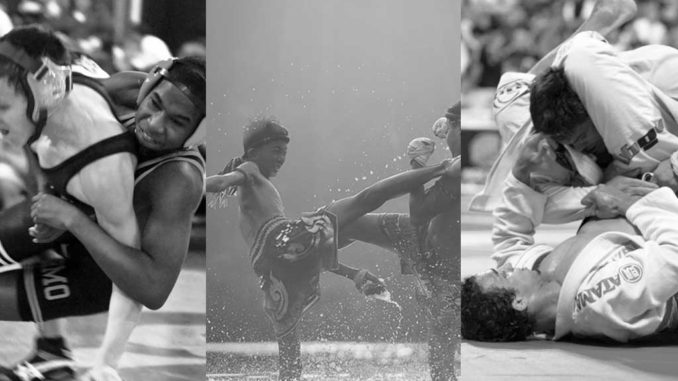
MMA or Mixed Martial Arts – from its name, the word “mixed” implies that is a combination of several existing martial arts. While it is true that most successful early MMA fighters had to combine several martial arts and fighting disciplines to be successful, for example, combinations of BJJ (Brazilian Jiu-Jitsu) and Kickboxing, or Freestyle Wrestling plus Boxing, there is no required or standard combination of martial arts or disciplines needed to compete in MMA.
It is just by necessity that most fighters combine different martial arts to be able to effectively compete in MMA. In truth you can compete even if you knew just one fighting discipline (or even if you knew no fighting discipline for that matter, like those uhmm.. “street fighters”), but you probably won’t get so far in MMA.
For example, a wrestler who only knew wrestling, if he won’t be able to finish his opponent after a take down, would be picked apart by someone who had decent striking (kicking and punching) skills. A very good kickboxer who didn’t know any grappling wouldn’t stand much of a chance against a fighter.
As the examples illustrate, in the mixed of Mixed Martial Arts usually have by necessity of mix of a striking martial art and a grappling martial art, the two broad definitions of a martial arts.
What are striking martial arts? Striking in martial arts refers the use of strikes, such as punches, kicks, knees, elbows and headbuts. The most common of these would be Muay Thai, kickboxing, boxing, Taekwondo, Karate, Savate, kung-fu, like Wing Chun.
What are grappling martial arts? Grappling in martial arts refers to the use of wrestling moves like throws, trips, takedowns, pinning, and submission holds, such as chokes, arm locks, leg locks, and other similar moves. Examples of a grappling martial art would be Jiujitsu (both Brazilian and Japanese variants), Judo, Sumo, wrestling, Sambo and Aikido. (Read: What is the Difference Between Grappling, Wrestling and Jiujitsu?)
Of course, there are some martial arts or fighting disciplines that have become almost standard in top-level MMA because of their effectivity. These are:
- Muay Thai
- Brazilian Jiujitsu
- Freestyle Wrestling
Muay Thai the kickboxing art from Thailand has become the most standard style and training for kickboxing. I feel almost hesitant to write down Muay Thai since there are so many styles of kickboxing, such as American Kickboxing, Dutch kickboxing Chinese kickboxing or Sanshou, and all of them having produced extremely brilliant fighters. And all of these styles tend to borrow heavily from each other. Muay Thai however has had the largest influence on all of these kickboxing forms and directly or indirectly influences almost all modern MMA fighter fighters. I would like to also including boxing as well, but the punches of Muay Thai itself in turn was heavily influenced by western boxing. For many Muay Thai trainers, their techniques for punching are identical or practically identical to boxing.
Brazilian jiujitsu or BJJ is the most prominent grappling martial art in MMA. (Read: What is exactly is BJJ or Brazilian Jiujitsu?) Proficiency in BJJ is necessary for success in MMA at all levels of competition. Its effectiveness stems from its history as a fighting art mean to be able to take-on all comers (read: Is Brazilian Jiujitsu Really from Brazil: A Deep Dive into the History of Brazilian Jiujitsu). The techniques employed BJJ over the years have been refined, and continue to evolve, as more effective ways of catching your opponent in submission holds and controlling them in ground fight develop. While BJJ has become the default grappling art for most successful MMA fighter for general ground fighting and submission holds, the traditional set of skills BJJ does not have all the best answers for all MMA grappling questions.
Here comes in Freestyle wrestling. Freestyle wrestling, or simply just wrestling, has the most effective and widely takedown and takedown defense of all fighting disciplines. The most apparent factor in this is that freestyle wrestling developed as a sport that does not use the gi or the thick kimonos used in other arts like Judo, jiujitsu and Sambo. This made freestyle wrestling perfect for MMA. Freestyle wrestling as it is now is of course a combination of the best proven wrestling maneuvers from all over the world.
While these three martial arts: Muay Thai. BJJ and freestyle wrestling are by far the biggest contributors to the skills used by a majority of competitive MMA fighters, there are lots of top-level fighters have base martial arts other than these big three (a fighters base martial art is the martial art a fighter usually has specialized in, especially early in their athletic or fighting career.) Notable examples include: Lyoto Machida who has shown how effective karate can be in MMA (read quote from Lyoto Machida on The difference between a fighter and a martial artist), or Ronda Rousey who has shown the might of Judo in MMA, or Karo Parisian another MMA fighter known for using his Judo in MMA (Karo Parisyan even wrote a book about using Judo in MMA).
The skill set for a modern MMA however is developing into set of its own. The growing trend is for the sport to be taught as a whole, and no longer a separate set of skills from different arts. This brings us to philosophical but practical question: As fighters develop and pickout the most effective techniques from the martial arts and fighting disciplines of the world, evolving into a sport with a skill set that is truly its own, should the word “Mixed” in Mixed Martial Arts still be kept in the future?

Another amazing and informative article. Thanks so much for sharing.
Take care,
Damon.